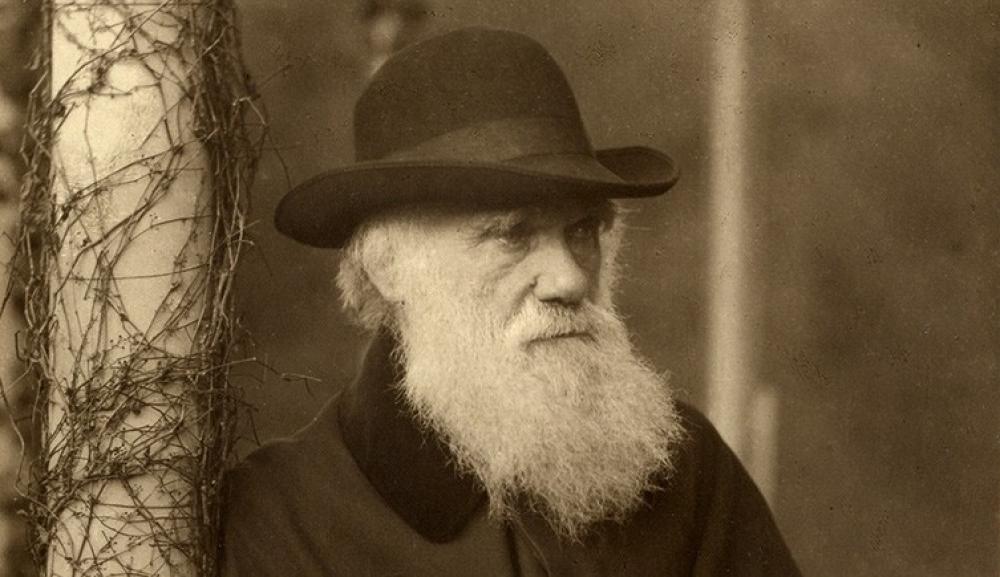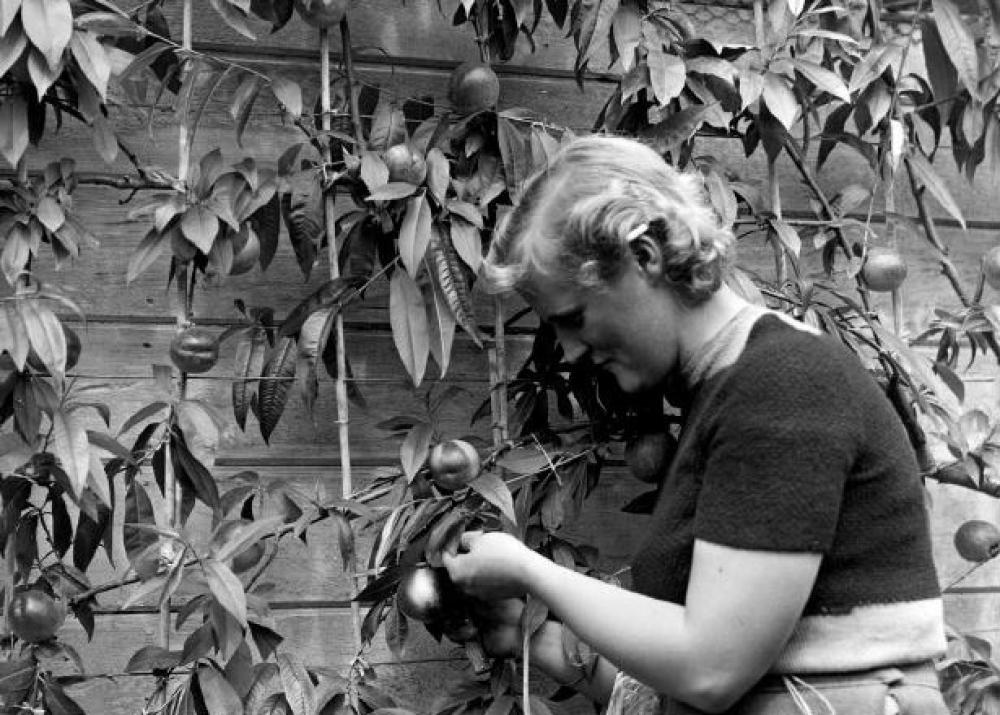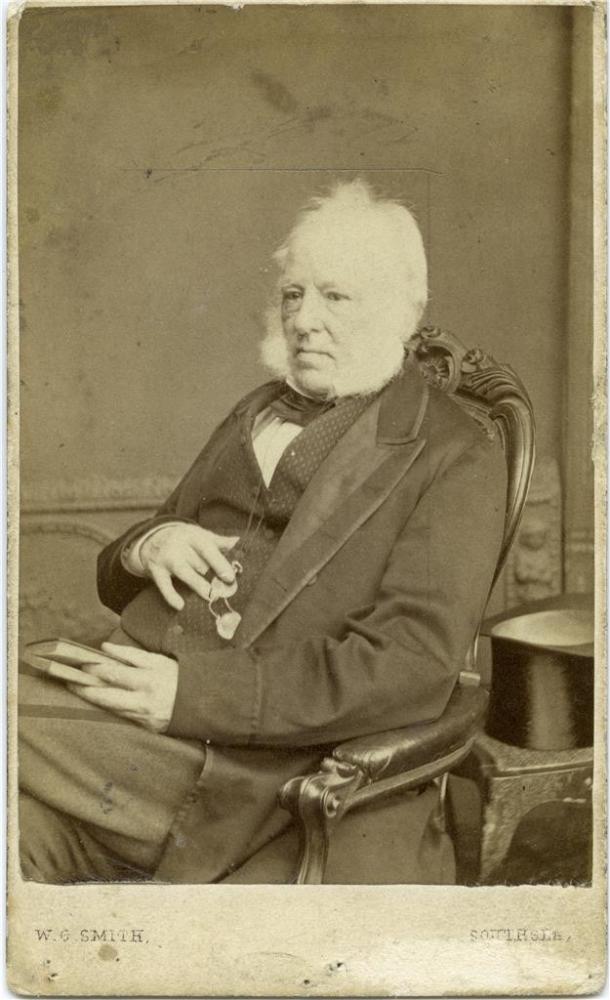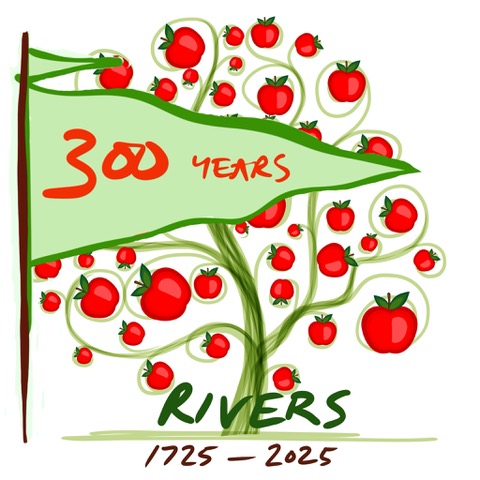New Varieties and Naming: What’s in a Name?
Written by Elizabeth Waugh
Published on March 1, 2025.
Return to the contents page.
The continuing reputation of Rivers Nursery and of the great Thomas Rivers, 1798 - 1877, rests in particular on his development of new cultivars of fruit, then named, often with nursery specific names such as Rivers Early Plum, and marketed. There were other successes: Rivers bare-rooted trees sold in great numbers and Thomas Rivers’ books on improving methods of growing were also popular. Yet in writing about his work at the time of his death, notable horticultural journals spoke of his development of new varieties as his most important achievement. Today too, Rivers cultivars continue to be planted and their qualities recognised.
Development of new fruit in the Nineteenth Century
How did new fruit varieties come into being? Chance and borrowing played a part. There is a story told by Thomas Rivers of coming home to his Sawbridgeworth grounds from a fruit exhibition with a basket of various overripe plums, then throwing the stones in a back corner, leaving them to grow on and a year or two or three later selecting the best to work with and observe. When a new selection had proved its worth over time, it was then named and marketed.
We also know that it was common practice for nurserymen to visit others’ grounds. Thomas Rivers visited Europe to look at, take note of and buy successful varieties grown elsewhere, particularly France. He did undoubtedly use budwood from plants others had developed and after testing his choices in English conditions, he would cultivate, modify and eventually sell them under his choice of name. Thomas, with his many publications and friendly style of writing, shared information with buyers and colleagues and discussed his working methods. His practices were usual and acceptable in the profession at the time.
However haphazard the genesis of new varieties in the nineteenth century and long before, after establishing a variety care was taken by the prominent growers to breed true. The method that ensured exact reproduction of the qualities of a successful fruit was grafting. In grafting, a small section of a desirable tree - a bud or scion - is joined to a selected root stock which gives the height and strength required to the new cloned tree that is then grown on until large enough to sell. Grafting also enabled large numbers of the desired trees to be produced to sell. This method depended on keeping a stock of trees to bud from, called mother trees. It is likely that at least some of the old trees presently in the restored Heritage Orchard were mother trees, kept in what had been an out-of-the-way area in the Nursery.
At Rivers there were staff members who specialised in grafting. One was Kath Walsh, pictured in a photograph in the Hertfordshire Archives taken during the WWI period. She worked with such trees as are termed Rivers cultivars, a word indicating a variety which a nursery has worked with and developed that is then propagated and distributed. There are listed on our website 43 Rivers cultivars in the present Heritage Orchard, among other old varieties produced by other nurseries but also sold from Rivers catalogues.
Changes at Rivers Nursery in the Twentieth Century
By the time of the last Thomas Rivers (1901-1978), great changes had come with regard to developing new cultivars. Any such process and the identification of cultivar qualities and choice of root stock had been taken over from Rivers, as well as other nurseries, by the East Malling research station in Kent, and carried out there in a more exacting scientific manner. Moreover, by then much of the Rivers stock was being bought in from a wholesale specialist nursery in Worcestershire as is described by Tony Slingsby, the last manager of the Nursery, (see ‘Propagation by T. Slingsby in Rivers Nursery of Sawbridgeworth, 2009). The Rivers Nursery was effectively only a retail business rather than, as it had been in the nineteenth century, a company known for developing new varieties. However, when the business closed in the 1980s at least some of the stock of the specialist Rivers cultivars was saved. Now it is possible to buy named Rivers cultivars such as the Rivers Early Plum from distributors such as EEAOP (East of England Apples and Orchards Project).
Developing ‘Scientific’ Breeding Practices
There might seem a sudden great leap in breeding practices between the apparently casual nineteenth century approach and the rigorous twenty-first century one. In fact, much of a scientific method was sought for and gradually evolved by Rivers and his fellow growers.
Though the nineteenth century Thomas writes about casually scattering plum stones, he also notes that he documented his discoveries. An article written about him at the time of his death in The Gardeners’ Chronicle on October 27th 1877, describes Rivers’ development process as having two plans: one is ‘of selection from seedlings of known origin’ and the other ‘of direct cross breeding’. In both cases Rivers had a ‘pedigree book’ and kept exact records - records of which article’s author says ‘we may hope will one day see the light, as their value from a scientific point of view would be very great’. There were ‘thousands of uncrossed seedlings raised by him of which only an infinitesimal number were preserved’. None of those records have in fact so far been found.
Thomas Rivers’ reputation and the methods and theories he writes about in his articles drew attention from another questing nineteenth century scientist interested in botany and inheritance - Charles Darwin. Between 1862 and 1872, the two carried on a lively exchange of letters, with Darwin asking detailed questions and requesting samples and Rivers responding. They moved over the years from a respectful distance to queries about health and plans to meet although it seems they never did. Thirty-one of their letters survive and can be read online in the Darwin Correspondence Project at Cambridge University.
Darwin in 1863 offers Rivers a signed copy of Origin of Species and Rivers in responding writes as follows: ‘When I first read the Origin I was amused at what I had observed with regard to selection. A patch of seedling trees if not transplanted seems to illustrate this (but perhaps I am taking a wrong view) the first year they are all equal, in two or three years several will have pushed up, at the end of five or six years one or two or three will have smothered nearly all their brethren & then one alone will be left. (Letter to Darwin 3965, 3 Feb. 1863)
Darwin replies: ‘What you say of seedlings conquering each other well illustrates the “struggle for existence” & “natural selection”. I have often & often looked at a crowd of natural seedlings with just such feelings and reflexions as yours.’ (Letter to Rivers, 3982, 14 Feb. 1863. See Chapter Five, in Rivers Nursery of Sawbridgeworth, 2009 for additional discussion.)
Naming
When a new variety was ready to market, the grower needed to choose a name. Fruit might carry the Nursery name such as in Rivers Early Plum and Cherry. Or new varieties might be given a title referring to an event as was the Czar Plum launched to the market in 1874 after a visit to Britain of the Czar of Russia. The Conference Pear was named for the fruit conference held in 1885. Or on the list of Rivers cultivars on our website, there are some names evocative of taste or appearance, like the apple, Rivers Peach.
In other words at Rivers’ time, there was naming by choice and no further stringent process. The Book of Apples by Joan Morgan describes this problem of names: ‘100s if not 1000s of varieties existed by the end of the 18th century and little was known of any - the result was that an apple was often known by a different name not only in another country or county but in an adjacent village’.
Rivers and his fellow growers were hindered by this continuing confusion. In April, 1854 Thomas Rivers published an article, ‘Proposal for a Pomological Society’, in the journal The Florist, Fruitist and Garden Miscellany. He wants to have a forum for discussions about names of fruit and comparison of fruit traits and best growing conditions. He compares the detailed discussions held in other countries in Europe and North America to the lack of joint effort in Britain and the impact of declining standards on the national fruit growing industry and the market for fruit.
Others agreed and on November 6 1855, there was held in Covent Garden the ‘First Extraordinary Meeting’ of the British Pomological Society.
Present Day Naming Practice
How do modern scientific methods impact on traditional names? Genetic information has become available through DNA testing. One of the uses of DNA analysis is cultivar identification. This may have a great and challenging impact when it reveals that our everyday way of naming has to give way to something different. An example is in the aster family which DNA identification has revealed to be vast and actually of more than one group so that those of us who cheerfully were certain of the simple naming of a common valued plant grown in every autumn garden must now use a longer more difficult botanical name that was previously unknown. Currently, at Royal Horticultural Society Hyde Hall Garden in Chelmsford, are entertaining displays to help us gardeners understand these changes and how they have come about.
For apples, DNA testing reveals that many different names may obscure the same genetic fingerprint. An article on Rosemoor in the RHS Garden magazine of 7 March, 2024, describes how to find the DNA of an apple: ‘Apple DNA is extracted from fresh spring foliage using a glorified hole punch to get two leaf discs. These are crushed in a centrifuge using a ball bearing to expose genetic material, from which the DNA can be identified.’ It is a complicated procedure and not one to be accessed at a Community Apple Day when you go along hoping to find the name of an old apple fruit found in a garden you’ve just inherited. It is clearly best in those circumstances to use pictures and taste and experience as certainly centrifuges are not portable. A rigorously applied naming process based on charts of characteristics can suggest how best to use the apple you hold in your hand, whether to leave it late on the tree to develop its flavour or let it melt into apple sauce or keep shape in an apple pie or simply to bite into it then and there. See FruitID, a ‘community created catalogue for apple identification’, which is very useful if applied by local expert helpers.
However, what DNA analysis can reveal as well as name identification is traits that may be useful for withstanding climate change or varieties that extend a fruiting season or other important qualities.
Registration of Plant Names
Does every ‘new’ plant variety created have to be verified? Today each new fruit variety in the UK, if it is to be marketed, must be tested against extensive government guidelines to determine if the new plant is ‘distinct, stable and uniform’. There are long government issued forms to fill in and the process takes time. Establishing a distinct name is part of the process. DNA testing may be required. This testing, registering, naming process is no longer left only to the growers’ choice. The needs of the national industry of growing fruit requires rigour to maintain its market share and reputation. The need for accuracy was perceived and gradually worked towards in the nineteenth century by Rivers and his contemporaries. Now there is a standard registration process designed to achieve a national and international standard. To this process there is a strict warning attached. Government guidelines: ‘You must add a new plant variety to UK National lists before marketing or face prosecution.’ This gives protection in a crowded market and not only penalty.
The charity, Brogdale Collections in Kent, holds the National Fruit Collection, one of the largest in the world, with examples of all named British varieties. It was set up there in 1952 after being moved from Wisley and is owned by the East Malling Trust which ‘promotes the advancement of science in horticulture’. There is a continuing strong connection between the RHS and Brogdale. There are continuing growing trials and committee discussions and more.
So what’s in a name? Let us look at the current worldwide favourite of Rivers cultivars which is sold from Europe to Japan - the Conference Pear:
Conference Pear, Pyrus communis
- named by Thomas Francis Rivers in Sawbridgeworth for its launch at a fruit conference in 1885
- listed in the National Fruit Collection retrospectively during the period from 1973 - 1999
- searched, the name triggers a long list of recorded growth and appearance traits
- also known is that a pear has 17 chromosomes, compared with a human for example which has 23
The Conference pear has a name which is definitive and unique, which unrolls before us not only its characteristics but its history. Its name ensures that this pear, while it may be larger or smaller, fully ripe or not as you eat it, is declared by its name to be the same as every other Conference pear.
This Rivers cultivar also has the extra ‘personal’ history of having been drawn for identification purposes by TF Rivers’ daughter, May, whose work too has become famous. This then is the Conference pear, the nation’s favourite.
Further Reading:
Introduction to DNA fingerprinting of apples and pears: produced for the participants
of FruitID.
Rivers Nursery of Sawbridgeworth, 2009 (available to purchase from the Rivers website).
Also see Colin's article, published at the same time as this article. The careful naming conventions and rules described in this article are critical to ensuring the fruit obtained for restocking the Rivers Orchard are the same at those developed by Rivers many years ago.
See Bibliographical information within the text above
Elizabeth Waugh February, 2025

Charles Darwin. |

Kath Walsh, expert in grafting for Rivers Nursery. |

Thomas Rivers, 1798 - 1877. |


